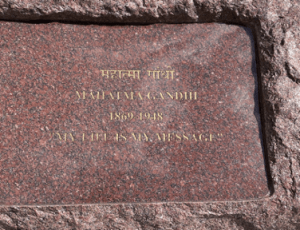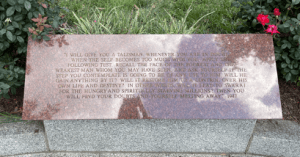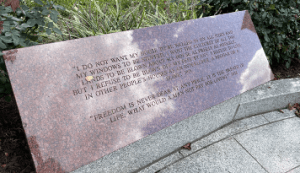The Great Soul: Gandhi the Father of India, Gandhi the Misogynist, and Gandhi the Racist

by Tanya A. (all photos her credit)
Gandhi the Memorial: History and Construction

Located on a triangular island along Massachusetts Avenue in the nation’s capital sits a statue of Mohandas K. Gandhi, commonly remembered as the Father of India due to his contributions to the Indian fight for independence from the United Kingdom. The statue is located in front of the Indian embassy and is meant to be a tribute to a historically admired figure. However, this memorial also highlights some great controversies surrounding Mohandas Gandhi.
The history behind the memorial celebrates the increasing Indian population in the United States. Because the Indian immigrant population in America has increased tenfold in the last 40 years, it seems fitting that the presence of this vibrant community would be memorialized in the nation’s capital.

In fact, Indian-Americans originally requested this memorial, which was supported by a bill in Congress and ultimately signed by President Bill Clinton in 1999. Gandhi statues in America aren’t new; Indian-Americans have been successful in advocating for such statues in San Francisco, New York City, Houston, Atlanta, and other metropolitan hubs. However, because of DC’s unique significance as the capital of the nation, this particular statue holds a larger significance for many groups — Indian-Americans, women, and black Americans.

The memorial itself is beautiful and powerful, towering over viewers by being over 8 feet tall. Built of granite excavated from India and casted in bronze, the statue depicts Gandhi in an active pose reminiscent of his famous 1930 march to protest the UK’s salt tax. As a result, the statue shines light on a specific aspect of Gandhi: the inspiring revolutionary.
The memorial was sculpted by Gautam Pal, who has sculpted numerous statues of Gandhi outside the Indian subcontinent. On the pedestal, the famous Gandhi quote “My life is my message” is inscribed. This quote exemplifies the crux of Gandhi’s philosophy: lead by example, which in his case, included advocating for non-violence, conducting hunger strikes, risking imprisonment, and giving grand speeches that would later influence freedom-fighters such as Nelson Mandela.

Gandhi the Man: Great Soul and Father of India
Although Gandhi was named Mohandas at birth, he has been eternalized as Mahatma Gandhi. Mahatma translates to “the Great Soul” in Sanskrit, the ancient traditional language of the Indian subcontinent. He has also been named “The Father of India” due to his contributions to and leadership during the Indian struggle for independence. Gandhi made major sacrifices for this movement. He spent much of his life away from his family in prison; he compromised his physical health; and ultimately, he lost his life while upholding his beliefs. Through extended imprisonment, hunger strikes, eloquent speeches, and numerous marches, Gandhi was an inspiration for Indian freedom-fighters and is often credited for popularizing non-violent revolution at a global scale.
Prominent global leaders later claimed they were inspired by Gandhi, including Nelson Mandela, who said that “in a world driven by violence and strife, Gandhi’s message of peace and non-violence holds the key to human survival in the 21st century”. Furthermore, Obama later wrote that Gandhi, along with “Lincoln, King, and Mandela, … profoundly influenced [his] thinking”. Obama celebrates Gandhi’s “devotion to truth, and the power of non-violent resistance to stir the conscience; his insistence on our common humanity and the essential oneness of all religions; and his belief in every society’s obligation, through its political, economic, and social arrangements, to recognize the equal worth and dignity of all people”. It is evident that Gandhi left behind an inspirational legacy, creating the popular view of him as a positive role-model for leaders.


Gandhi the Controversy: Misogyny and Racism
Despite historically popular views, there has been a growing awareness of Gandhi’s shortcomings as a human — primarily, his sexism and racism. Although Gandhi didn’t share outwardly misogynistic views on women, he had controversial beliefs on gender roles. While on one hand, he thought of women as essential to the liberation movement, he also adhered to traditional gender roles and agreed with the notion that women should be relegated to housework. His most controversial view was that women should be celibate and resist all men, including their husbands — the sole purpose of sex, in his views, was procreation.
While he is not unique in holding this view, Gandhi took his views to the extreme when he conducted an “experiment” to demonstrate his commitment to celibacy. Gandhi asked his teenage grand-niece to lie naked next to him in bed, so that he could test his ability to control his sexual urges. Besides being deeply pedophilic, this “experiment” demonstrated Gandhi’s views that women are inherently sexual objects, and one must actively hold back the urge to engage in sexual relations.
There are many problematic factors of this experiment. By choosing his grand-niece, with whom he shared a blood relationship, Gandhi essentially made the claim that any and all women could be viewed in a sexual manner. Additionally, because she was a teenager at the time, Gandhi has been accused of being a pedophile. Critics claim that if Gandhi conducted this “experiment” to control his sexual urges, it means that he must have had a sexual attraction towards his teenage grand-niece to begin with. Regardless of his intentions in conducting the “experiment”, it is evident that he struggled deeply with his sexuality and held sexist and pedophilic views.
Even more controversial than his views on women are Gandhi’s views on Africans. While a young lawyer in South Africa, Gandhi produced many writings that requested a separate entrance for Indians so that he would not have to share one with black South Africans, used racial slurs liberally, and advocated for the recognition of the Indo-Aryan race, which he deemed to be superior to other races. Because of these controversial beliefs, statues of Gandhi have been protested by individuals across the world from Ghana to Davis, California. Additionally, after the murder of George Floyd in the summer of 2020, the Gandhi statue in DC was one of many to be vandalized, triggering a conversation about Gandhi’s controversial racist beliefs (see image below).

Behind the statue lies a plaque that mentions Gandhi’s work in South Africa, but in a positive light, noting his determination to fight racism (see image below). This is particularly controversial, as it glorifies his work in South Africa without addressing his deeply ignorant and bigoted writings. To many, this plaque consciously engages in attempting to write over history and protect Gandhi’s legacy rather than showing an accurate description of him as a flawed man.

Furthermore, he was also an advocate for the caste system in India, a form of racial subjugation and violence that spans back centuries. He once wrote that “if Hindu society has been able to stand, it is because it is founded on the caste system”. However, as he became a more popular figure, he later claimed that “untouchability was a blot on Hinduism”, where untouchability refers to the lowest caste. Historians generally concur that Gandhi changed his views when they were questioned by other prominent leaders. It’s possible that this change of views led to his assassination in 1948 by a Hindu nationalist.
Many defenders and descendants of Gandhi claim that while his views were ignorant, he wasn’t a hateful person because he later recanted his views on Africans and the caste system. It’s difficult to know definitively if these defenses are accurate, or if they are just efforts to preserve Gandhi’s legacy. Nonetheless, these controversies surrounding Gandhi are often overshadowed by his teachings on peaceful resistance.
Gandhi the Symbol
Given Gandhi’s complicated life, it is important to ask ourselves what this statue means today. The best answer is, like Gandhi himself, it’s complicated. While Gandhi is remembered as the pinnacle of freedom and bravery to many individuals, he is a reminder of the ultimate form of bigotry and white supremacy to others. With black leaders like Nelson Mandela and Barack Obama revering his legacy, it becomes difficult to decide if he should be forgiven for his racist writings and sexist practices considering his contributions to promoting freedom and liberation non-violently.
At the heart of the debate, it is important to recognize that the controversies surrounding Gandhi reveals what it means to be human: imperfect, dynamic, and complex. Gandhi’s earlier works are imperfect; they stem from a place of deep ignorance and perhaps bigotry. However, many scholars claim that the change in his views over time demonstrates the complexity and evolution of his thinking and the reality of being a dynamic human. Essentially, we recognize the fatal flaw with all idols: they are always short of perfection, just like those that idolize them. We must recognize that both the memorial and its observer are flawed.
Additionally, this memorial forces us to ask ourselves at which point a person has contributed enough ‘good’ to overshadow the ‘bad’ they brought to the world. Is Gandhi’s legacy of non-violence sufficient to compensate for his earlier racist writings and later sexual experiments with his grand-niece? That’s a question that every observer of the Gandhi statue must reflect on and decide for themselves.
The location of the statue:
Further reading:
Gandhi in DC
Welcome to Embassy of India, Washington DC, USA, https://www.indianembassyusa.gov.in/memorial?id=14.
This link describes the statue in DC and has numerous links to its history, sculptor, and design.
Gandhi the Father of India
History.com Editors. “Mahatma Gandhi.” History.com, A&E Television Networks, 30 July 2010, https://www.history.com/topics/india/mahatma-gandhi.
If you’re interested in learning more about Gandhi’s teachings and impact on the Indian liberation movement, this article provides the basic history of Gandhi’s life.
Guha, Ramachandra. Gandhi: The Years That Changed the World, 1914-1948. Penguin Books, 2019.
One of the most popular biographies of Gandhi, this book chronicles his life and contribution to the Indian liberation movement.
Gandhi the Misogynist
Biswas, Soutik. “Manu Gandhi: The Girl Who Chronicled Gandhi’s Troubled Years.” BBC News, BBC, 30 Sept. 2019, https://www.bbc.com/news/world-asia-india-49848645.
This article is about Manu Gandhi, Gandhi’s grand-niece. In Gandhi’s later life, he asked her to lay next to him in bed, naked, so that he could demonstrate that he can control his sexual desire.
Kishwar, Madhu. “Gandhi on Women.” Economic and Political Weekly, vol. 20, no. 40, Economic and Political Weekly, 1985, pp. 1691–702, http://www.jstor.org/stable/4374897.
If you’re interested in learning more about Gandhi’s conflicting views on women, this article delves into his personal struggle with balancing liberty with traditional gender roles.
Gandhi the Racist
Wootson, Cleve R. “After a Petition Called Gandhi ‘Racist,’ His Statue Was Removed from the University of Ghana.” The Washington Post, WP Company, 16 Dec. 2018, https://www.washingtonpost.com/world/2018/12/15/after-petition-called-gandhi-racist-his-statue-was-removed-university-ghana/.
After students at the University of Ghana protested the Gandhi statue on campus, the University took it down. The students pointed to his racist writings earlier in his career as the reason for their protest.

